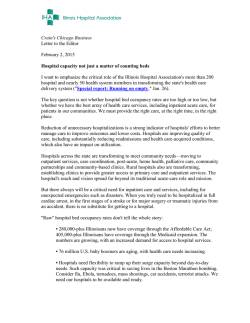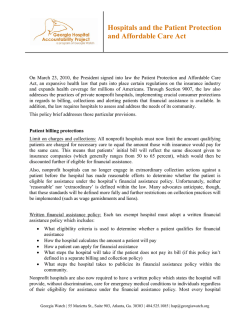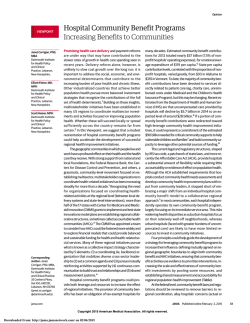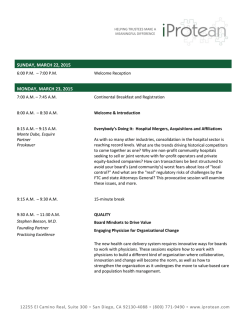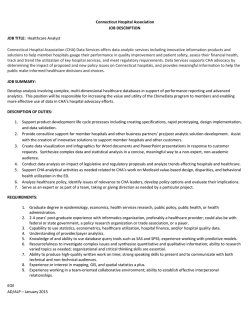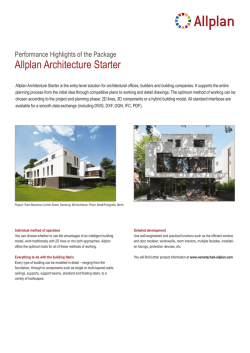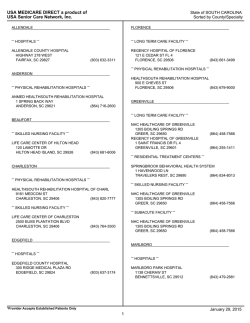
Preventing Blindness in China
CASE STUDY Preventing Blindness in China Aier Eye Hospital: Efficient Management Leads to Clear Vision for Millions of Chinese November 2015 ABOUT IFC IFC, a member of the World Bank Group, is the largest global development institution focused exclusively on leveraging the power of the private sector to tackle the world’s most pressing development challenges. Working with private enterprises in more than 100 countries, IFC uses its capital, expertise and influence to help eliminate extreme poverty and promote shared prosperity. ABOUT THE CASE STUDY Expanding access to quality and affordable health care is a central element to eliminating extreme poverty and promoting shared prosperity. The World Bank Group has a goal of ending preventable deaths and disability through Universal Health Coverage (UHC). In many developing countries, governments do not have the capacity to service the entire population and private health care providers often play a critical role in meeting the needs of society. IFC’s health practice is developing case studies that demonstrate the contribution of the private sector to achieving global and national health care goals. Through a focus on efficiency and innovation, certain business models can provide better outcomes at a lower overall cost to society. WRITTEN BY This case study was written by Ann M. Casanova with inputs from Ioan Cleaton-Jones, Charles Dalton, Linshuo Hao, Alicia Jie Hu, Edward Hsu, Edward Chung Nin Keung, Chris McCahan, Elena Sterlin, and Jiadi Yu. Content was largely drawn from a report developed for IFC “Aier Eye Hospital Case Study: Private Hospital Case Study” by Dr. Vivian Chen. ACKNOWLEDGEMENTS A special note of appreciation is extended to Aier Eye Hospital Group. Photo credits: Aier Eye Hospital Group. The author is grateful for the many insights provided by IFC colleagues. Special thanks to Elizabeth Price for communications advice and Irina Sarchenko for the creative design. DISCLAIMER The findings, interpretations, views and conclusions expressed herein are those of the author and do not necessarily reflect the views of the Executive Directors of the International Finance Corporation (IFC) or of the World Bank or the governments they represent. While IFC believes that the information provided is accurate, the information is provided on a strictly “as-is” basis, without assurance or representation of any kind. IFC may not require all or any of the described practices in its own investments, and in its sole discretion may not agree to finance or assist companies or projects that adhere to those practices. Any such practices or proposed practices would be evaluated by IFC on a case-by-case basis with due regard for the particular circumstances of the project. RIGHTS AND PERMISSIONS © International Finance Corporation 2015. All rights reserved. The material in this work is copyrighted. Copying and/or transmitting portions or all of this work without permission may be a violation of applicable law. Table of Contents Eye Care For All 1 Efficient Business Model Promotes Quality Care 5 Strong Core Values 13 Partnerships 15 The Role of IFC 19 Conclusion 21 iv | Preventing Blindness in China EYE CARE FOR ALL A 10-year-old girl named Yan Yan was from an impoverished family living in a small, poor village in Guizhou province, China. Her parents had serious mental health and substance abuse problems, so she lived with her 82-year-old grandmother. Yan Yan was cooking dinner at home when her right eye was struck directly by an arrow shot by her brother, who was playing with his homemade bow and arrow. Her right eye was lacerated, and she lost sight in it completely. Yan Yan was taken to a Yan Yan fully recovered her sight thanks to the specialists she saw through the Aier network. few hospitals in Guizhou Province, and each hospital said she would not be able to recover her sight. Two weeks after the injury, her case came to the attention of management at Aier Eye Hospital. They quickly arranged for Yan Yan to be seen at the local Aier Guizhou Hospital. All of the expert ophthalmologists in the Aier network were consulted through a video conference, and they discussed Yan Yan’s treatment plans. They determined that Yan Yan needed to go to Aier Chengdu Hospital, the only hospital in Western China possessing the endoscopic equipment required for her treatment. Aier Guizhou Hospital arranged the logistics and accommodations, and even purchased new clothes for Yan Yan. Immediately after she arrived at Aier Chengdu hospital, the most experienced specialist there examined Yan Yan. Her eye injury was very serious – delayed treatment and severe bleeding made it difficult to check the retinal and optic nerve. In addition, bacteria in the eye could cause endophthalmitis, an inflammatory condition that damages vision. A treatment plan was developed, and the first stage operation on Yan Yan lasted two hours. The surgery went very well, and a few hours after the surgery, Yan Yan could begin to vaguely see through her right eye. After a second surgery, Yan Yan later fully recovered her sight.1 Aier Corporate Social Responsibility Report, 2013. 1 Preventing Blindness in China | 1 The rapid, compassionate, response reflects the strong core values that drive the company. Mr. Chen Bang, founder and Chairman of Aier Eye Hospital Group, explains, “First we are a hospital, and then an enterprise. We try to help all people, rich or poor, to enjoy healthcare.”2 Aier provides high quality treatment to all Chinese, regardless of their socio-economic level or whether they live in rural or urban arears. To date, Aier Eye Hospital Group has helped nearly 20 million3 Chinese people prevent blindness and continue to be productive members of society. In a country of 1.4 billion people, where 18 percent of the world’s blind population resides and where blindness is growing at a rate of 6 percent per year, the Chinese government has sought to address the nation’s massive problem – particularly for avoidable blindness, such as that caused by cataracts.4 Recognizing that it does not have the capacity to combat all treatable blindness through public institutions, the government has progressively liberalized policies to encourage more private sector participation. Liberalization has Aier helps prevent included granting legal protection for profits derived from hospitals as income. “The reforms allowed the use of private capital to run for-profit hospital services, and Aier was one of the earliest pioneers to respond and act quickly.”5 avoidable blindness such as cataract. Aier Eye Hospital Group Company Ltd., was established in 2002 and opened its first hospital in Changsha in early 2003. In China, most eye surgery is done on an in-patient basis due to constraints found in the system. Hospitalization for eye surgery occurs widely in China notwithstanding that in many countries eye surgery is conducted on an out-patient basis. The company promotes improved vision through four main business lines: (1) LASIK6 surgery to correct shortsightedness, (2) cataract surgery to eliminate blindness, (3) specialized eye surgeries or treatments of rare and complex conditions, including corneal transplants, glaucoma, and retina diseases, and (4) optometry diagnostic services, and corrective lens provision. Since the company opened its first hospital 12 years ago, Aier has grown to a network of 100 hospitals in more than 26 provinces. Today, Aier is the largest domestic ophthalmology institution in China and it is growing very quickly. IFC played a catalytic role in Aier’s growth. In 2006, IFC provided a RMB 64 million (US$ 8 million) loan to Aier to support the expansion of the hospital network, to increase access to high quality eye care, and to demonstrate best practice to the medical community. IFC’s investment positioned Aier for an IPO in 2009. The growth of the network has enabled it to pursue a high-volume business model that has yielded strong financial results. In 2014, it had revenues of US$ 378 million and net profits of US$ 49 million.7 Ernst and Young. Winner Entrepreneur of the Year Award 2014. China. 2 This figure includes free examinations and screenings. 3 WHO: Blindness as a Public Health Problem in China. 4 Aier Eye Hospital Case Study: Private Hospital Case Study. Dr. Vivian Chen, pg. 3. 5 LASIK is a laser surgery that reshapes the cornea in order to improve visual acuity. 6 In 2014, Aier had RMB 2,402 million in revenues and RMB 313 million in net profits. The foreign exchange rate as of 7 September 16, 2015 was US$ 1: RMB 6.36. www.oanda.com 2 | Preventing Blindness in China STRATEGIC BUSINESS MODEL The keys to Aier’s success as a private health care provider in China is found in a strategic business model that emphasizes efficient management, high quality care, and strong core values. Aier’s success has been magnified because it effectively leverages partnerships. E FFICIENT MANAGEMENT LEADS TO HIGH QUALITY To gain market share, Aier modernized the way ophthalmology care was undertaken in China. Aier maximizes service utilization of talent, equipment and infrastructure through its multi-tier network by allocating doctors and equipment to locations where they are needed most. It efficiently controls infrastructure costs by leasing buildings and retrofitting interior spaces to create a hospital environment. Further, it manages costs by purchasing in volume and negotiating discounts directly from suppliers, thereby enabling it to reach economies of scale. The network manages staff time efficiently which helps contain costs. The sequence, flow, and division of responsibilities are clearly established so that doctors get support from nurses and customer service staff which allows doctors to spend more quality time with patients. Clinical pathways clearly define standards and responsibilities for each staff member which leads to a low infection rate. The result is better quality for patients and greater access to eye care for the Chinese people. S TRONG CORE VALUES HELPS GROW THE BUSINESS Aier embeds core values into its business model and this has helped gain the trust of patients. Aier eliminated several corrupt practices that are commonplace at many other Chinese hospitals. It strictly prohibits the “red envelope,” or cash payments by patients to doctors. It eliminated unnecessary prescriptions of drugs and prohibited procurement malfeasance, practices that increase costs to patients. It makes prices for medical services transparent by publishing them in the lobby. P ARTNERSHIPS Aier has a deep commitment to community outreach. Through its Corporate Social Responsibility Program, which it implements through partnerships, Aier brings free or low cost diagnostic services to youth and elderly living in marginalized communities. Its CSR efforts enable it to diagnose more serious cases which need to be referred to its hospitals. Aier has pioneered innovative partnerships that have contributed to growth. Through its employee-shareholder program, Aier incentivizes key medical staff to invest in the company thereby enabling additional expansion of new Aier hospitals. The program also serves as a retention strategy for its key doctors. To address the skills shortage, Aier established the first public-private partnership with two different public universities to offer formal degree programs. Today, Aier trains 70 percent of its new ophthalmologists, thereby ensuring a steady stream of qualified doctors for its growing network. The internal management procedures, standards, and policies that Aier has established provide a blueprint that has enabled it to scale up quickly. This gives Aier an ability to replicate the model quickly and efficiently, while safeguarding quality and cost-efficiency. As a result, the company serves as a benchmark for many local authorities who send officials to Aier to learn from its model and replicate its practices in the public sector. Education Within Reach of All | 3 4 | Preventing Blindness in China EFFICIENT BUSINESS MODEL PROMOTES QUALITY CARE As Aier entered the market it became clear that it would not be easy for a private company to earn the public trust and build clients. Private medical care in China had been stigmatized for decades in a way that is unique in emerging markets. Private care was considered to be of poor quality and run with the sole mission of generating profits. If Aier was going to run a sustainable business, it had to be the antithesis of the negative stereotype; it had to earn the trust of the public and the government. It developed a competitive and efficient business model, which is centered on careful management of costs, diversified revenue streams and positive medical outcomes. Aier has accomplished positive results, although some of its expenses are higher as compared to public hospitals. It pays 25 percent in corporate taxes and it pays its doctors more, all with little government assistance to defray operating expenses. It can do this because it achieves high volumes. It has reached economies of scale through the network and has a crosssubsidized pricing structure which allows it to leverage luxury services, thereby offsetting the cost of services for low-income patients. This is all made possible through the hospital network model, which is a key part of its success and long term sustainability. The multi-tier hospital network promotes efficiencies and expands the reach of quality care. MULTI-TIER HOSPITAL NETWORK Aier adapted the classic multi-tier level of health care and adapted it to ophthalmology while introducing it to the Chinese market. While the model is typical in other countries, it did not previously exist in China. The network allows Aier to take advantage of many synergies that stand alone hospitals do not enjoy. “The network model also increases efficiency and lowers cost, because it shares medical resources, such as doctors and equipment across the three tiers.”8 The tiers serve as a fully functioning ecosystem. Tier III and IV hospitals, located in secondary cities, serve as the gateway, while Tier I and II hospitals provide technical support to Tier III hospitals. Tier I also includes large cross-regional hospitals, such as its flagship Shanghai Aier Hospital. The three-tier model, combined with the process management standards (see below), allows Aier to deliver consistent quality of care across the network. Chen at pg. 14. 8 Preventing Blindness in China | 5 MULTI-TIER CHAIN MODEL The multi-tier chain model helps achieve synergies among hospitals at different levels and follows the good public health practice of offering primary, secondary and tertiary level care with a clear chain of referral between levels in accordance with the complexity of the patient’s problem. Aier Eye has also built two community centers in Changsha to provide access to eye care at the community level. VI TIER HOSPITALS/ CLINICS Located at county level, Tier IV hospitals and clinics focus on screening, check ups and basic diagnosis/ treatment for general eye diseases. III TIER II TIER I TIER HOSPITALS HOSPITALS HOSPITALS Located in lower-tier, prefectural-level cities, Tier III hospitals focus on optometry and diagnosis / treatment for general eye diseases. Located in provincial capital cities, Tier II hospitals serve as the core business operating platform, offering full range of eye-care services to patients. Located in Shanghai and serving as the flagship Aier Hospital, as well as offering full-range of eye-care services, Shanghai Aier Hospital focuses on clinical/academic research and provides technical support to tier II, tier III and tier IV hospitals. THE LOWEST TIER III AND IV HOSPITALS EXTEND AIER’S BRAND AND GEOGRAPHICAL COVERAGE AND PROVIDE REFERRAL POINTS FOR PATIENTS TO TIER II AND I HOSPITALS. MEANWHILE, TIER I AND II HOSPITALS PROVIDE TECHNICAL SUPPORT TO THE TIER III AND IV HOSPITALS. 6 | Education Within Reach of All RENTING SPACE PROMOTES RAPID SCALABILITY Aier has adopted a model that is “asset light” to minimize long-term investments in infrastructure and free up capital to address other business needs. Aier found it was typically complex and time consuming to acquire land and build a new hospital. Furthermore, the process of establishing a new private hospital in China was long and required approximately 190 approvals from project initiation to commencement of operations.9 After the IPO, Aier decided to buy buildings in larger markets and rent space in smaller markets. This approach enabled Aier to expand faster into secondary cities and strategically focus resources where larger investments were needed, such as for its flagship hospital in Shanghai. Aier’s asset light model has contributed to its ability to scale up the network efficiently and expand its health care footprint faster. DIVISION OF LABOR KEEPS MANAGEMENT FOCUSED Breaking away from the Chinese public hospital model, Aier split up the responsibilities of the CEO, who has a business background, and the President, who is a doctor. This allowed them to focus on their respective core strengths of management and medicine. All hospitals follow this dual management model. Each CEO is responsible for the overall administration of the hospital from the business perspective. Responsibilities include: business operation, patient service, external corporate affairs, and government relations. Meanwhile, each president is responsible for medical treatment, clinical quality standards, new technology application, academic research, and professional exchanges. This bifurcated management model allows the CEO to attend to broader management and administrative matters and allows the hospital presidents to devote their energy and resources to patient treatment. In contrast, public hospitals combine these functions under the president, who is typically a physician and who often ends up investing significant amounts of time to attend to administrative matters. Nurses can provide quality care at lower cost. STRATEGIC MANAGEMENT OF PERSONNEL COSTS Ophthalmology lends itself to standardization and clear divisions of labor. Aier has standardized and mapped an efficient process flow to manage labor costs more efficiently. It has divided responsibilities across all personnel and allocates simpler tasks to lesser trained, lower paid staff such as nurses, technicians and optometrists. This strategy allows doctors to conduct more surgeries and drives patient volume. Further, as compared to public hospitals, Aier runs its operating rooms longer per day, enabling each doctor to perform more surgeries a day. “This practice reduces the cost of each task and spreads the cost of the doctor, the most expensive member of the team, across many more patients, reducing the cost per patient.”10 Comparatively, in most emerging markets and developed countries there are about 25 to 50 approvals required. 9 10 Chen at pg. 29. Preventing Blindness in China | 7 STATE OF THE ART TECHNOLOGY Many eye surgeries have been largely standardized and made very safe with the use of technology. Aier has made continuous and significant investments in advanced equipment, helping it earn a reputation as the technology leader in excimer and cataract surgery in China. In 2008, Aier introduced TORIC lenses for cataract surgery, which was a breakthrough for the Chinese market. In 2010, it introduced intraocular endoscopy and the use of laminar flow operating rooms. “In 2013, Aier introduced the world’s top femtosecond laser operation system and cataract femtosecond laser equipment for the treatment of myopia and cataract.”11 Aier’s investments in technology raised the bar for complex eye surgery in China and contributed to the company receiving an award for the “Top Ten China - Medical Service Quality.” Aier has emerged as the technology leader in excimer and cataract surgery in China, because of its significant investments in advanced equipment. SAFETY MANAGEMENT STANDARDS While eye surgery in many countries is typically done on an out-patient basis, due to constraints in the Chinese system, Aier had to set up hospitals to be able to participate in the social health insurance system. This was necessary in the local market even though there are more modern models available. Notwithstanding that social health insurance system reimburses hospitals based on the number of in-patient days, Aier reduced this practice to improve efficiency and patient experience. Aier developed clinical pathways that are more in line with standards in developed countries, thereby exceeding the guidelines established by the Ministry of Health and Family Planning Commission. For instance, in the case of cataract surgery, Aier reduces the hospital visit from seven days at a public hospital to three days at an Aier hospital. This is a good example of how the company focuses on patient care rather than on maximizing profits. At Aier, each eye disease treatment has a clinical pathway that covers process management standards for the pre-operative, intra-operative and post-operative stages. It clearly defines quality standards for doctors, nurses, technicians, operating environment, and medications. These standards minimize risk substantially and contribute to a low infection rate of about 1 in every 10,000 eye surgeries, which is far better than in the United Kingdom,12 which had an infection rate of 1 in every 1,820. 11 Chen at pg. 29. 12 Royal College of Ophthalmologists, Cataract Surgery Guidelines. September 2010, pg 13. https://www.rcophth.ac.uk/wp-content/uploads/2014/12/2010SCI-069-Cataract-Surgery-Guidelines-2010-SEPTEMBER-2010.pdf 8 | Preventing Blindness in China QUALITY TIME WITH PATIENTS In public hospitals, thousands of patients that walk in the door on a daily basis spend the whole day waiting to be seen by a doctor. With such long lines, doctors and nurses do not have the luxury of spending quality time with patients.13 In contrast to public hospitals, advance scheduling helps Aier to manage doctor and patient time more effectively and allows doctors to spend more quality time with the patient. PREVENTATIVE AND PRIMARY CARE Distinct from its public sector counterparts, Aier has introduced preventative care through its “out-patient department.” It offers a variety of services such as: vision screening, optician services through retail outlets and community eye clinics that are independent from the hospitals. Aier piloted an eye care partnership with the public school district in the city of Qingdao where it offers a variety of myopia prevention services for students including: mass vision screenings, free corrective lens prescriptions, and training teachers to position students, blackboards, projectors, and visual aids at appropriate distances to reduce the development of myopia in youth. The program helps build the brand and helps to cross-market additional eye health services to parents. The company expects to expand the program to other cities in the future. As a result of these efforts, Aier’s preventative services serve as a benchmark for preventative eye care in the Chinese market. Aier offers preventative screenings to detect myopia in children. CENTRALIZED PROCUREMENT Rather than each of its 100 hospitals handling purchases independently, Aier maximizes its buying power by centralizing procurement of medical equipment, hospital consumables, and medications. Eighty percent of procurement is centralized and 20 percent is determined by the individual hospitals. This strategy allows Aier to make purchases directly from the manufacturer and obtain large volume discounts. In contrast, public hospitals manage procurement as independent standalone hospitals, thus reducing their purchasing power. In addition, Aier carefully manages costs by prohibiting any bribery from medical representatives and every price is transparent. The resulting savings enables a more competitive pricing capacity. 13 Interview with Dr. Wang Lan: Aier Intech Eye Hospital. Beijing Relocation.com. January 7, 2013. Last visited on September 16, 2015. Preventing Blindness in China | 9 PRICING STRUCTURE Aier conducts research of the local markets. It carefully assesses price sensitivities and affordability by studying the income capacities of the particular population served by each of its facilities. To set its pricing schedule, Aier benchmarks to government prices to ensure that its fees for major eye treatments are aligned with or are lower than those of public hospitals. It also takes into consideration the pricing schedule established by the public insurance scheme. For some elective surgeries, such as LASIK, Aier charges more because it has earned the best reputation in the industry, and it has the most advanced technology. Prices are then carefully targeted and revised depending on local circumstances. Thus, pricing structures may vary from city to city. DIVERSIFICATION OF REVENUE STREAMS Aier analyzed its revenue streams by segmenting patients into the following four categories, reflecting their ability to pay: • Healthy patients with strong awareness of preventative care who are willing to pay • High-end patients with high income • Patients covered by government social insurance • Patients eligible for social charity support Today, several eye diseases are covered by basic social insurance programs, while elective surgeries or medical services are paid for out of pocket. The diversified revenue stream allows Aier to provide affordable, competitive and luxury services all under the same network, which facilitates a cross-subsidized pricing strategy that promotes access for patients from all socio-economic groups. CROSS SUBSIDIZED PRICE STRATEGY Aier charges a premium price for discretionary medical services, which enables it to cross-subsidize services for lower income patients. Aier charges higher prices for luxury services such as LASIK surgery, which provides permanent vision correction to patients with myopia, hypermetropia and astigmatism. The surgery is a compelling alternative to corrective lenses, particularly for a growing middle class. Since it is not covered by health insurance it is provided to patients on an out-of-pocket payment basis. Aier is able to earn a reasonable profit off of elective surgeries, which allows it to cross-subsidize health services for lower income patients. As a result, Aier accepts all patients, regardless of income level; there is always a mechanism to cover the cost of care. INSURANCE Aier was able to access the social health insurance program on a limited basis in 2006, but this was rare for a private hospital. Prior to 2009, private hospitals were in a strictly controlled market, dominated by public hospitals and had virtually no access to the social health insurance programs. The healthcare reform of 2009 opened up access to qualified, non-public healthcare facilities to receive payment from social health insurance. Most private 10 | Preventing Blindness in China facilities have historically not participated in the social health insurance, limiting many patients to seeking medical attention at public hospitals. But Aier’s strong brand, good reputation and CSR efforts have helped Aier to gain access to the insurance schemes earlier than its private sector peers. It is worth noting that while the Chinese population enjoys virtually universal access to the basic social health insurance program, the program does not cover all conditions and does not reimburse patients for all aspects of treatment. So, while a large share of Aier’s patients may have access to social health insurance, a large share also pays expenses out of pocket. REVENUES Notwithstanding the limitations on coverage, access to social health insurance is critically important as it means the hospital can serve a greater number of patients and generate more revenues. Over time, as access and coverage has grown, so have revenues. For instance, in 2006, only 4 percent of Aier’s revenues came from insurance, since coverage was mainly for cataract surgery. Similarly, Aier’s flagship hospital in Shanghai did not have access to the full social insurance program for many years, consequently it suffered losses for 8 consecutive years. In the first half of 2013, it gained access to the insurance program, which led to a 23 percent increase in the number of outpatient services and a 50 percent increase in total annual revenues. Today, social health insurance accounts for 25 to 30 percent of Aier’s total revenues, slightly less than the 38 percent of total Chinese health expenditure paid for by social health insurance. REVENUE SHARE IN 2014 In 2014, the largest share—one quarter—of Aier’s revenues came from Lasik surgery. Cataract and optometry were tied at 20 percent each. Medical examinations accounted for 13 percent while drug sales were 11 percent. To prevent abuses, Aier limits revenues from drug sales to 12 percent. 13%, Medical Examination Lasik, 25% 7%, Anterior Segment Operation 20%, Cataract 11%, Drug Sales Optometry, 20% Posterior Segment Operation, 4% Preventing Blindness in China | 11 12 | Preventing Blindness in China STRONG CORE VALUES ETHICAL PRACTICES BUILD PATIENT TRUST Aier’s success as a company depended on its ability to overcome a stigma historically associated with privately provided healthcare that was unique to China. Chen Bang explained his strategy to earn patient trust. “Industry standards and ethics are our minimum standard.” Aier incorporated core values of honesty, integrity and transparency into its business policies, practices and incentive structure. Doctors in China Aier strictly prohibits are often not well compensated, and in order to receive health services, patients are expected to pay doctors additional fees, a practice known as the “red envelope.” Despite this widespread practice in China, Aier strictly prohibits under the table payments. First, Aier compensates its doctors well. Then, it incentivizes doctors to report attempted bribes, and the company fires those who accept them. It makes its prices transparent by publishing the service fee schedule on a wall in the lobby. Patients are advised that no other charge is expected. the “red envelope,” a widespread practice of providing doctors with under the table payments. Similarly, supplemental payments are prohibited in procurement. Equipment is selected following an analysis of competing suppliers that takes into consideration the negotiated price and medical quality – as verified by clinical staff. A centralized procurement committee reviews recommendations and makes the final selection. In China, there is a widespread problem with doctors ordering unnecessary prescriptions for the sake of generating revenues. To provide the best quality care, Aier actively monitors and caps hospital revenue from prescriptions at 12 percent, which is lower than the hospital average of between 30 to 40 percent. Preventing Blindness in China | 13 14 | Preventing Blindness in China PARTNERSHIPS CORPORATE SOCIAL RESPONSIBILITY (CSR) With the goal of providing greater access to eye health to people living at the base of the economic pyramid and in frontier communities, Aier launched a corporate social responsibility (CSR) program. Aier travels to frontier regions of China and runs free eye clinics in communities. It conducts public education campaigns on eye care, offers free vision testing in schools and provides free eyeglasses to low-income people. It conducts free eye examinations in rural areas and refers cases that need additional treatment to Aier hospitals. Between 2003 and 2015, Aier conducted more than 2 million free eye diagnoses and screening examinations. The blindness screening program referred between 20 to 30 percent of total Aier patients.14 1 Through a cost-sharing partnership between the central government, local governments, and rural social medical insurance, as well as local and international charities, Aier provides free or subsidized cataract and glaucoma surgeries for disadvantaged people. In 2013, through its “Prevent and Treat Blindness” initiative it conducted nearly 90,000 cataract surgeries at zero or low profit. Aier leverages partnerships to provide high quality care at little to no cost to school children and low-income communities. The result is a win-win for all because low-income communities get high quality care at little to no cost. Governments advance public health objectives at lower cost, and the company cultivates a positive social image. This helps build the brand and contributes to the company’s growth. The company’s ethical policies and practices have helped earn the trust of patients and their families, as well as the government and insurance companies, which has helped attract more patients to Aier. EMPLOYEE - SHAREHOLDER INCENTIVE PROGRAM In 2014, Aier introduced an innovative incentive program, whereby Aier invited senior physicians and key medical staff to partner with the company as shareholders of new Aier hospitals. The cash infusion enables Aier to establish new hospitals with the financial and professional buy-in of its 14 Chen at pg. 30. Preventing Blindness in China | 15 key employees. When the profitability of the hospital reaches a certain level, the company can buy back the shares from its partners at a fair price. The arrangement also provides opportunities to physicians who were hesitant to open their own clinics, because of the high risks associated with opening a new medical practice. Given the competitive landscape for top talent, the program acts as an incentive to retain and motivate top doctors to stay with Aier over the long term, and it helps to accelerate the establishment of new hospitals. SPECIALIST TRAINING THROUGH PARTNERSHIPS Today, Aier employs 2,000 ophthalmologists across its network. The company’s sustainable growth depends on its ability to secure a steady stream of highly qualified doctors. Thus, Aier expanded its residency and specialist training programs. Aier pioneered the first public-private partnership in China between a private hospital network and two public universities. It established “Aier Academy of Ophthalmology” (2013) in partnership with Central South University, which offers formal degree programs for Masters and Doctoral level students and “Aier Medical School of Optometry” (2014) in partnership with Hubei Technology University. The Aier Eye Medical College program allows Aier to further strengthen and expand its overall research, clinical, and educational capacity needed for Masters and PhD programs, thereby enhancing its medical prestige and talent reserves. The overall result of its residency and postgraduate training efforts has ensured a reliable supply of specialized ophthalmologist doctors. As of 2014, Aier produced 70 percent of its needed new specialist ophthalmologists in-house and recruits the other 30 percent. Few private hospital groups in the world are able to satisfy such a large proportion of their specialist doctor needs from in-house training. 16 | Preventing Blindness in China The Aier Academy of Ophthalmology further strengthens its capacity to secure highly trained ophthalmologists, while expanding its research, clinical and educational capacity. 18 | Preventing Blindness in China THE ROLE OF IFC At the time of IFC’s investment in 2006, Aier was operating 8 eye-hospitals serving 40,000 patients. Its growth had been restricted by a lack assets for security, since hospitals in China cannot mortgage their land or buildings. IFC overcame this by obtaining a security interest in the equipment, intellectual property, and an equity pledge against the borrower’s shares. Chen Bang said, “IFC’s RMB 64 million (US$ 8 million) loan in 2006 with a low cost and long tenor was very suitable for the healthcare industry because it requires a long investment cycle, which was crucial to Aier Eye’s network expansion in the early stages of establishing 6 new hospitals. IFC brought to Aier international standards and best practices in various aspects, such as medical quality management, operational improvement, as well as social and environmental responsibility.” For IFC, Aier brought a good fit with the health sector strategy of increasing medical access and expanding private sector capacity to address unmet societal needs. The relationship with IFC provided a quality endorsement, positioning Aier for an IPO. Three years after IFC’s investment, Aier was successfully listed on the Shenzhen Stock Exchange, the first listed medical institution in the A-share market, where it raised RMB 882 million (US$ 139 million) to stimulate additional growth in China. Since then, Aier has grown substantially and has a market capitalization of over US$4.8 billion today. Preventing Blindness in China | 19 20 | Preventing Blindness in China CONCLUSION Over the last 12 years, Aier has become the largest private hospital group in China and the leader in treating eye conditions. It has proved that the private sector is a key strategic partner, alongside the government, to achieve its public health care objectives of combating blindness in China with very good patient outcomes and cost efficiency. These results have validated the government’s strategy of involving the private sector to advance broader societal goals and have greater impact. Further, the results reinforced the belief that private sector health care is essential for expanding access to health care services to underserved communities in frontier regions. Through efficient management, standardization and cross-subsidized pricing strategies, Aier has reduced the overall cost of health care, while delivering effective patient outcomes for all socio-economic levels. It has achieved high quality eye care health services through the development of clinical pathways, standardization, and hiring of excellent doctors who use state of the art equipment to achieve positive patient outcomes. Through its strong core values, Aier has brought integrity to the provision of private health care in China. Earning the public trust has helped the company build the brand and access the social health insurance program. Through partnerships, it has increased access for the base of the pyramid, while ensuring that it can continue to expand with a reliable base of highly trained ophthalmologists. It has cultivated a business model that is scalable and sustainable, and as Chen Bang anticipates, will continue to be in business “for the next 100 years.” Most importantly, Aier has brought opportunities for millions of Chinese people to be productive and contributing members of society by preserving their ability to see. Preventing Blindness in China | 21 STAY CONNECTED WEB: www.ifc.org/health LINKEDIN: www.linkedin.com/company/ifc-health TWITTER: #ifchealth For more information about IFC’s investments in health please contact: Elena Sterlin Global Manager, Health and Education Email: [email protected] Washington, D.C., USA www.ifc.org/health www.ifc.org/education 2121 Pennsylvania Ave. NW Washington, DC 20433 Tel. 1-202-473-1000 24 | Preventing Blindness in China Chris McCahan Global Lead, Health Care E-mail: [email protected] Washington, D.C., USA www.ifc.org/health
© Copyright 2025
